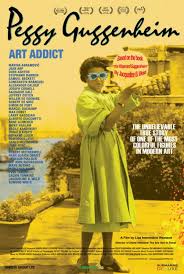
PEGGY GUGGENHEIM: ART ADDICT
US, 2015, 96 minutes, Colour.
Directed by Lisa Immordino Vreeland.
Peggy Guggenheim was an extraordinary figure in the art world of the 20th century. Not an artist herself, she was collector, patron of the arts, fostering new talent, fostering a sensibility for 20th-century modern art, founder of a very significant gallery.
This is both a portrait of Peggy Guggenheim as well as an appreciation of her role in art.
One of the interesting features of the film is that the director has incorporated a great deal of footage from the periods of Peggy Guggenheim’s life, using footage from newsreel, documentary material, feature films of those times. This brings to life the various periods with an authentic and historical feel.
Her family were migrants from Europe, coming poor to the United States, building up their family and fortune. She married into the wealthy Guggenheim family, her uncle being Solomon Gorgon home who founded the Gallery collection in New York City. The film shows her relationship with her two children, her successful son and her tragic daughter.
The film utilises many photo portraits of Peggy, filmed material, so that the audience has a feel for what she looked like at various stages in life, from young to almost 80, with a commentary that explains her background, her education, her interest in art, the beginnings of her collection, her significance.
She spent some time in Paris, mixing with so many celebrities, especially the American ex-patriates, in the 1920s and into the 1930s, where she started to exercise her taste, began to collect as well as to be a dealer in selling many paintings. This continued during the 1930s but she returned to the United States at the outbreak of World War II, bringing all her art works with her.
During the 1940s, she continued to foster talent, the film detailing many of the artists, but most especially Jackson Pollock, and showing her, growing older, her marriages, her affairs, and her place in American society.
She decided that she did not want to stay in the United States and moved back to Europe, choosing Venice as her favourite city, buying a palazzo, setting it up as a gallery, incorporating the various works of art and continually increasing them – over 300 at the time of her death. She collaborated with the Guggenheim in New York City though she was not close, personally, to her uncle Solomon.
She lived in Venice from 1947 until her death in 1979. There is a great deal of footage of her during these years, made an honorary citizen of Venice, building on to the gallery, seeing it become a Mecca for art lovers and art students.
As expected, there are many talking heads, a range of artists, range of celebrities (and for film lovers, an interview with Robert De Niro, his mother’s paintings being in the gallery). There are speculations about her character, relationships, the consciousness of herself as an art collector.
The film is of interest to the general public although there is much more detail and presentations of art than they might be able to deal with. But, of course, it is a must for the visuals of the works of art, the backgrounds of the artists, and an appraisal of Peggy Guggenheim’s contribution to art in the 20th century.